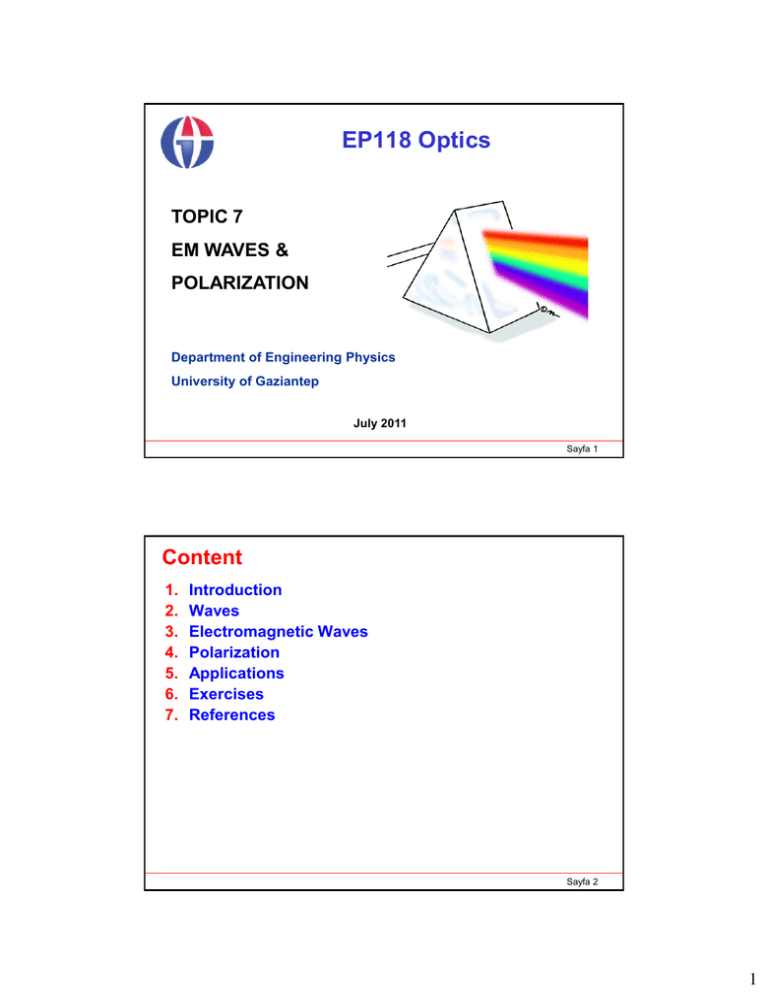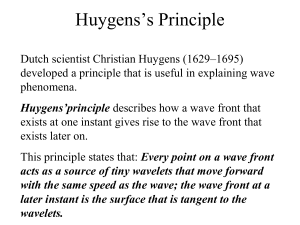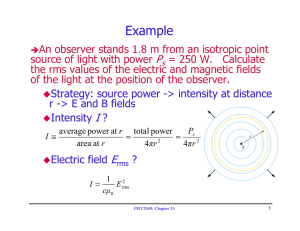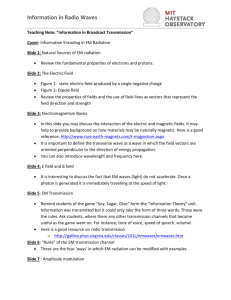EP118 Optics
advertisement

EP118 Optics TOPIC 7 EM WAVES & POLARIZATION Department of Engineering Physics University of Gaziantep July 2011 Sayfa 1 Content 1. 2. 3. 4. 5. 6. 7. Introduction Waves Electromagnetic Waves Polarization Applications Exercises References Sayfa 2 1 7.1 Introduction In this section, we will investigate basic properties of electromagnetic waves (EMW) polarization of light and its applications. Sayfa 3 7.2 Wave λ : wavelength f : frequency v : speed of the wave v=fλ In mathematics and science, a wave is a disturbance that travels through space and time, usually accompanied by the transfer of energy. Sayfa 4 2 Mechanical Waves sound water string waves … Electromagnetic Waves Light Radio waves X-ray … Wave Quantum Mechanical Waves to describe the probability density of a particle! Gravitational Waves disturbances in the curvature of space-time! (Not observed). Sayfa 5 Wave Transverse Waves the displacement of the medium is perpendicular to the direction of propagation of the wave. e.g. Water wave, EMW Longitudinal Waves the displacement of the medium is parallel to the propagation of the wave. e.g. sound wave. Sayfa 6 3 7.3 Electromagnetic Waves EMW is a form of energy exhibiting wave-like behavior as it travels through space. EMW has both electric field (E) and magnetic field (B) components, which * oscillate in phase * perpendicular to each other and * perpendicular to the direction of energy propagation * James Clerk Maxwell first theoretically postulated EMWs (in 1862). * These were confirmed by Heinrich Hertz experimentally (in 1886). Sayfa 7 7.4 Polarization Polarization is a property of certain types of waves that describes the orientation of their oscillations. Only transverse waves have polarization effect (e.g EMWs, GWs). Longitudinal waves do not have polarization since the direction of vibration and direction of propagation are the same (e.g. sound waves) To explain polarization effect for EMWs, it is sufficient to consider only the electric field component. Sayfa 8 4 Polarization can be obtained from an unpolarized beam by Selective absorption by Reflection by Scattering We’ll only see selective absorbtion. Sayfa 9 When the electric field vectors are restricted to a single plane by filtration, then the light is polarized with respect to the direction of propagation. Sayfa 10 5 Each atom produces a wave with its own orientation of E. All directions of the electric field vector (E) are equally possible and lie in a plane perpendicular to the direction of propagation. This is an “unpolarized” wave. A wave is said to be linearly polarized if the resultant electric field vibrates in the same direction at all times at a particular point. Sayfa 11 Polarizer (Polaroid): The molecular structure of a polarizer causes the component of the E field perpendicular to the Transmission Axis to be absorbed. Sayfa 12 6 The intensity of the polarized beam transmitted through a polarizing sheet is one-half of the original intensity of the unpolarized wave. Sayfa 13 The intensity of the polarized beam transmitted through the second polarizing sheet (the analyzer) varies as: I = I0 cos2(θ) * Io is the intensity of the polarized wave incident on the analyzer. * This is known as Malus’ Law and applies to any two polarizing materials whose transmission axes are at an angle of θ to each other. Sayfa 14 7 The intensity of light transmitted through two polarizers depends on the relative orientation of their transmission axes Sayfa 15 EXAMPLE 1 Unpolarized light passes through two Polaroid sheets. The axis of the first is vertical, and that of the second is at 40 to the vertical. What fraction of the incident light is transmitted? SOLUTION Lets assume that light has the initial intensity I0. The light intensity after 1st Polaroid: I1 = I0/2. The light intensity after 2nd Polaroid: I2 = I1 cos2(40o) = 0.59 I1 = 0.30 I0 Sayfa 16 8 EXAMPLE 2 Plane-polarized light is incident on a single polarizing disk with the direction of E parallel to the direction of the transmission axis. Through what angle should the analyzer disk be rotated so that the intensity in the transmitted beam is reduced by a factor of 5? SOLUTION Lets assume that polarized light has the intensity I0. The light intensity after analyzer: I I 0 cos2 ( ) or cos( ) I I0 1 5 0.447 63.40 Sayfa 17 7.5 Applications In photography, polarizing filters are used, mostly to improve the appearance of the sky (deeper blue, and clouds more visible): The effects of a polarizing filter on the sky in a photograph. The picture on the right uses the filter Sayfa 18 9 Sunglasses The hazard of driving (or performing other daily activities) with a large amount of glare in one's eyes has resulted in the development of polarized sunglasses. The lenses of such sunglasses contain polarizing filters that are oriented vertically with respect to the frames. Polarized sunglasses eliminate the glare from the surface of a highway Sayfa 19 3D Movies Polarization is also used for some 3D movies. Images intended for each eye are, typically, projected from a single projector with time multiplexed polarization. Polarized 3D glasses with suitable polarized filters ensure that each eye receives only the intended image. Sayfa 20 10 Communication All radio transmitting and receiving antennas are intrinsically polarized. Most antennas radiate either horizontal, vertical, or circular polarization. AM and FM radio use vertical polarization, while television uses horizontal polarization. Sayfa 21 7.6 Exercises 1. What is the difference between polarized and un-polarized wave? 2. Unpolarized light (like the light from the sun) passes through a polarizing sunglass (a linear polarizer). The intensity of the light when it emerges is a) zero b) 1/2 what it was before c) 1/3 what it was before d) 1/4 what it was before e) need more information 3. Horizontally polarized light passes through the sunglasses (which are vertically polarized). The intensity of the light when it emerges is a) zero b) 1/2 what it was before c) 1/3 what it was before d) 1/4 what it was before e) need more information Sayfa 22 11 4. A polarizer for microwaves can be made as a grid of parallel metal wires about a centimeter apart. Is the electric field vector for microwaves transmitted through this polarizer (a) parallel or (b) perpendicular to the metal wires? 5. Unpolarized light passes through two polaroid sheets. The axis of the first is vertical, and that of the second is at 15 to the vertical. What fraction of the incident light is transmitted and absorbed? 6. Plane-polarized light is incident on a single polarizing disk with the direction of E parallel to the direction of the transmission axis. Through what angle should the analyzer disk be rotated so that the intensity in the absorbed beam is increased by a factor of 0.3? Sayfa 23 7.7 References 1. Serway, Beichner, Physics for Scientists and Engineers 6th ed, Brooks/Cole 2. http://en.wikipedia.org/wiki/Wave 3. http://en.wikipedia.org/wiki/Electromagnetic_wave 4. http://en.wikipedia.org/wiki/Polarization_(waves) 5. http://micro.magnet.fsu.edu/optics/lightandcolor/polarization.html 6. http://hyperphysics.phy-astr.gsu.edu/hbase/sound/tralon.html Sayfa 24 12


![Hints to Assignment #12 -- 8.022 [1] Lorentz invariance and waves](http://s2.studylib.net/store/data/013604158_1-7e1df448685f7171dc85ce54d29f68de-300x300.png)



